Experimental Study on Hybrid Effect Evaluation of Fiber Reinforced Concrete Subjected to Drop Weight Impacts
Abstract
1. Introduction
2. Experimental Programme
2.1. Material Composition
2.2. Mix Proportioning and Concrete Production
2.3. Test Method
3. Test Results and Discussion
3.1. UC and 3PBT Results
3.2. Drop Weight Impact Test Results
3.2.1. Fiber Reinforcement Effect on Impact Response
3.2.2. Hybrid Effect Evaluation on Impact Energy Absorption
4. Conclusions
- (1)
- The improvement of impact energy property of concrete discs can be achieved by the incorporation of polymer (PP/PVA) fiber or steel fiber. The fiber reinforcement transfers the impact failure patterns from brittleness to ductility.
- (2)
- Steel fiber addition can better improve the compressive strength, flexural strength and impact strength than its PP or PVA fiber counterpart. Damage modes suggest that the steel fiber tends to pulled out from the matrix while rapture usually occurs to the polymer fiber.
- (3)
- A linear equation describing the first crack and failure strength can be best fitted for both Steel-PP HFRC and Steel-PVA HFRC. The derived equation provides a reasonable model for prediction of the relationship of first crack and failure strength.
- (4)
- In general, the failure impact energy of Steel-PP HFRC decreases with the increasing PP content while the increasing PVA content may lead to the increase of failure impact energy. With constant 1% PP, the hybrid with more SF cause significant improvement of impact strength.
- (5)
- The reinforcement of steel fiber and PP fiber provides positive hybrid effect on improvement of the failure impact energy. For Steel-PP HFRC with 2% fiber content, the impact energy absorption capacity and fiber hybrid effect increase with the increasing of SF dosage.
- (6)
- The combined use of steel fiber and PVA fiber suggests less positive hybrid effect on failure impact energy. Especially when theSF content exceeds the PVA content, the hybrid effect index is almost 1, i.e., the corresponding impact energy can be regarded as simply sum of SFRC and PVA FRC.
Author Contributions
Funding
Acknowledgments
Conflicts of Interest
References
- Caner, F.C.; Bažant, Z.P.; Wendner, R. Microplane model M7f for fiber reinforced concrete. Eng. Fract. Mech. 2013, 105, 41–57. [Google Scholar] [CrossRef]
- Zhang, W.; Chen, S.; Zhang, N.; Zhou, Y. Low-velocity flexural impact response of steel fiber reinforced concrete subjected to freeze–thaw cycles in NaCl solution. Constr. Build. Mater. 2015, 101, 522–526. [Google Scholar] [CrossRef]
- Feng, J.; Sun, W.; Liu, Z.; Cui, C.; Wang, X. An armour-piercing projectile penetration in a double-layered target of ultra-high-performance fiber reinforced concrete and armour steel: Experimental and numerical analyses. Mater. Des. 2016, 102, 131–141. [Google Scholar] [CrossRef]
- Abdallah, S.; Fan, M.; Rees, D.W. Bonding Mechanisms and Strength of Steel Fiber–Reinforced Cementitious Composites: Overview. J. Mater. Civ. Eng. 2018, 30, 04018001. [Google Scholar] [CrossRef]
- Schauffert, E.A.; Cusatis, G.; Pelessone, D.; O’Daniel, J.L.; Baylot, J.T. Lattice discrete particle model for fiber-reinforced concrete. II: Tensile fracture and multiaxial loading behavior. J. Eng. Mech. 2011, 138, 834–841. [Google Scholar] [CrossRef]
- Feng, J.; Sun, W.; Wang, X.; Shi, X. Mechanical analyses of hooked fiber pullout performance in ultra-high-performance concrete. Constr. Build. Mater. 2014, 69, 403–410. [Google Scholar] [CrossRef]
- Hsie, M.; Tu, C.; Song, P. Mechanical properties of polypropylene hybrid fiber-reinforced concrete. Mater. Sci. Eng. A 2008, 494, 153–157. [Google Scholar] [CrossRef]
- Wang, P.; Huang, Z.; Zhou, D.; Wang, X.; Zhang, C. Impact mechanical properties of concrete reinforced with hybrid carbon fibers. J. Vib. Shock 2012, 31, 14–18. [Google Scholar]
- Brzyski, P.; Barnat-Hunek, D.; Fic, S.; Szelkag, M. Hydrophobization of lime composites with lignocellulosic raw materials from flax. J. Nat. Fibers 2017, 14, 609–620. [Google Scholar] [CrossRef]
- Ramezanianpour, A.A.; Esmaeili, M.; Ghahari, S.A.; Najafi, M.H. Laboratory study on the effect of polypropylene fiber on durability, and physical and mechanical characteristic of concrete for application in sleepers. Constr. Build. Mater. 2013, 44, 411–418. [Google Scholar] [CrossRef]
- Sun, Z.; Xu, Q. Microscopic, physical and mechanical analysis of polypropylene fiber reinforced concrete. Mater. Sci. Eng. A 2009, 527, 198–204. [Google Scholar] [CrossRef]
- Li, Q.; Zhao, X.; Xu, S.; Gao, X. Influence of steel fiber on dynamic compressive behavior of hybrid fiber ultra high toughness cementitious composites at different strain rates. Constr. Build. Mater. 2016, 125, 490–500. [Google Scholar] [CrossRef]
- Fu, Q.; Niu, D.; Zhang, J.; Huang, D.; Wang, Y.; Hong, M.; Zhang, L. Dynamic compressive mechanical behaviour and modelling of basalt–polypropylene fibre-reinforced concrete. Arch. Civ. Mech. Eng. 2018, 18, 914–927. [Google Scholar] [CrossRef]
- Yao, W.; Li, J.; Wu, K. Mechanical properties of hybrid fiber-reinforced concrete at low fiber volume fraction. Cem. Concr. Res. 2003, 33, 27–30. [Google Scholar] [CrossRef]
- Szelkag, M. Mechano-physical properties and microstructure of carbon nanotube reinforced cement paste after thermal load. Nanomaterials 2017, 7, 267. [Google Scholar] [CrossRef] [PubMed]
- Bentur, A.; Mindess, S. Fibre Reinforced Cementitious Composites; CRC Press: Boca Raton, FL, USA, 2006; pp. 726–732. [Google Scholar]
- Sivakumar, A.; Santhanam, M. Mechanical properties of high strength concrete reinforced with metallic and non-metallic fibres. Cem. Concr. Compos. 2007, 29, 603–608. [Google Scholar] [CrossRef]
- Ding, Y.; Li, D.; Zhang, Y.; Azevedo, C. Experimental investigation on the composite effect of steel rebars and macro fibers on the impact behavior of high performance self-compacting concrete. Constr. Build. Mater. 2017, 136, 495–505. [Google Scholar] [CrossRef]
- Song, W.; Yin, J. Hybrid effect evaluation of steel fiber and carbon fiber on the performance of the fiber reinforced concrete. Materials 2016, 9, 704. [Google Scholar] [CrossRef]
- Shah, A.A.; Ribakov, Y. Recent trends in steel fibered high-strength concrete. Mater. Des. 2011, 32, 4122–4151. [Google Scholar] [CrossRef]
- Wang, Z.; Shi, Z.; Wang, J. On the strength and toughness properties of SFRC under static-dynamic compression. Compos. Part B Eng. 2011, 42, 1285–1290. [Google Scholar] [CrossRef]
- Su, Y.; Li, J.; Wu, C.; Wu, P.; Tao, M.; Li, X. Mesoscale study of steel fibre-reinforced ultra-high performance concrete under static and dynamic loads. Mater. Des. 2017, 116, 340–351. [Google Scholar] [CrossRef]
- Sun, X.; Zhao, K.; Li, Y.; Huang, R.; Ye, Z.; Zhang, Y.; Ma, J. A study of strain-rate effect and fiber reinforcement effect on dynamic behavior of steel fiber-reinforced concrete. Constr. Build. Mater. 2018, 158, 657–669. [Google Scholar] [CrossRef]
- Shah, S.P.; Daniel, J.I.; Ahmad, S.H.; Arockiasamy, M.; Balaguru, P.; Ball, C.G.; Ball, H.P.; Batson, G.B.; Bentur, A.; Craig, R.J.; et al. Measurement of properties of fiber reinforced concrete. ACI Mater. J. 1988, 85, 583–593. [Google Scholar]
- Nia, A.A.; Hedayatian, M.; Nili, M.; Sabet, V.A. An experimental and numerical study on how steel and polypropylene fibers affect the impact resistance in fiber-reinforced concrete. Int. J. Impact Eng. 2012, 46, 62–73. [Google Scholar]
- Song, P.; Wu, J.; Hwang, S.; Sheu, B. Statistical analysis of impact strength and strength reliability of steel–polypropylene hybrid fiber-reinforced concrete. Constr. Build. Mater. 2005, 19, 1–9. [Google Scholar] [CrossRef]
- Yildirim, S.T.; Ekinci, C.E.; Findik, F. Properties of hybrid fiber reinforced concrete under repeated impact loads. Russ. J. Nondestr. Test. 2010, 46, 538–546. [Google Scholar] [CrossRef]
- Wille, K.; El-Tawil, S.; Naaman, A.E. Properties of strain hardening ultra high performance fiber reinforced concrete (UHP-FRC) under direct tensile loading. Cem. Concr. Compos. 2014, 48, 53–66. [Google Scholar] [CrossRef]
- Yoo, D.Y.; Lee, J.H.; Yoon, Y.S. Effect of fiber content on mechanical and fracture properties of ultra high performance fiber reinforced cementitious composites. Compos. Struct. 2013, 106, 742–753. [Google Scholar] [CrossRef]
- Banthia, N.; Sheng, J. Fracture toughness of micro-fiber reinforced cement composites. Cem. Concr. Compos. 1996, 18, 251–269. [Google Scholar] [CrossRef]
- Banholzer, B.; Brockmann, T.; Brameshuber, W. Material and bonding characteristics for dimensioning and modelling of textile reinforced concrete (TRC) elements. Mater. Struct. 2006, 39, 749–763. [Google Scholar] [CrossRef]
- Sedan, D.; Pagnoux, C.; Smith, A.; Chotard, T. Mechanical properties of hemp fibre reinforced cement: Influence of the fibre/matrix interaction. J. Eur. Ceram. Soc. 2008, 28, 183–192. [Google Scholar] [CrossRef]
- Mahmud, G.H.; Yang, Z.; Hassan, A.M.T. Experimental and numerical studies of size effects of Ultra High Performance Steel Fibre Reinforced Concrete (UHPFRC) beams. Constr. Build. Mater. 2013, 48, 1027–1034. [Google Scholar] [CrossRef]
- Rahmani, T.; Kiani, B.; Shekarchi, M.; Safari, A. Statistical and experimental analysis on the behavior of fiber reinforced concretes subjected to drop weight test. Constr. Build. Mater. 2012, 37, 360–369. [Google Scholar] [CrossRef]
- Halvaei, M.; Jamshidi, M.; Latifi, M. Effects of Hybridization of Carbon and Polypropylene Short Fibers as Reinforcement on Flexural Properties of Fine Aggregate Concretes. Civ. Eng. J. 2016, 2, 520–528. [Google Scholar]
- Yap, S.P.; Alengaram, U.J.; Jumaat, M.Z. Enhancement of mechanical properties in polypropylene–and nylon–fibre reinforced oil palm shell concrete. Mater. Des. 2013, 49, 1034–1041. [Google Scholar] [CrossRef]
- Mechtcherine, V.; Silva, F.D.A.; Müller, S.; Jun, P.; Filho, R.D.T. Coupled strain rate and temperature effects on the tensile behavior of strain-hardening cement-based composites (SHCC) with PVA fibers. Cem. Concr. Res. 2012, 42, 1417–1427. [Google Scholar] [CrossRef]
- Zhang, C.; Cao, M. Fiber synergy in multi-scale fiber-reinforced cementitious composites. J. Reinf. Plast. Compos. 2014, 33, 862–874. [Google Scholar] [CrossRef]
- Ostle, B. Engineering Statistics: The Industrial Experience; Wadsworth Publishing Company: Belmont, CA, USA, 1996. [Google Scholar]

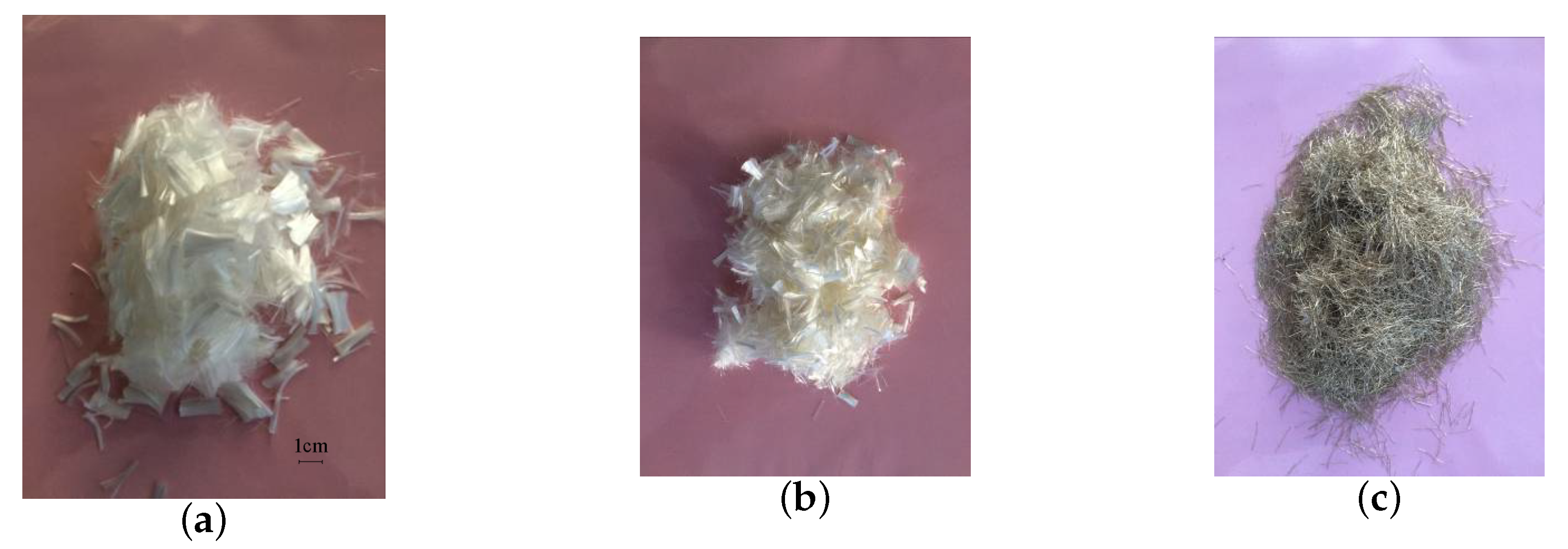
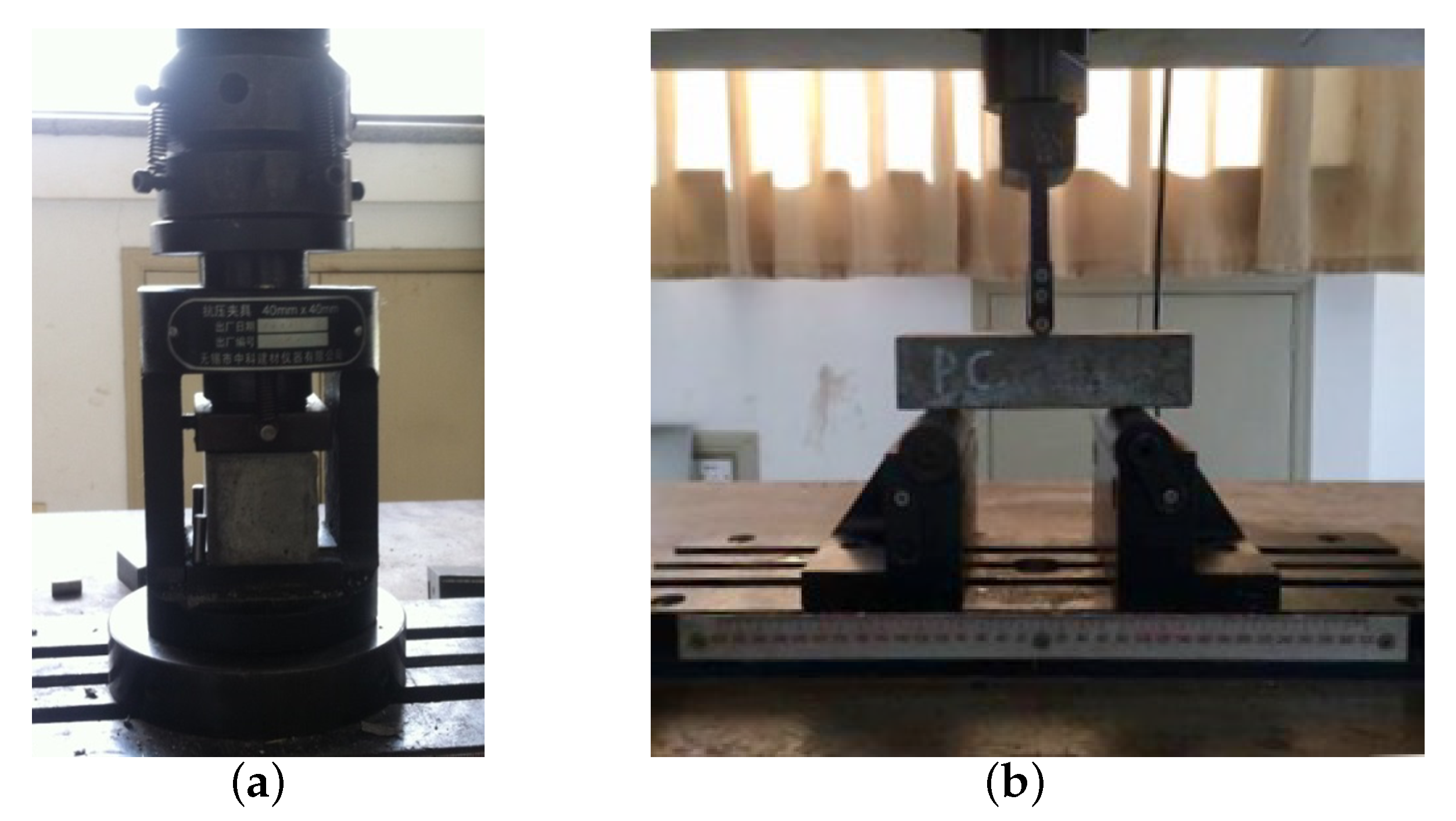
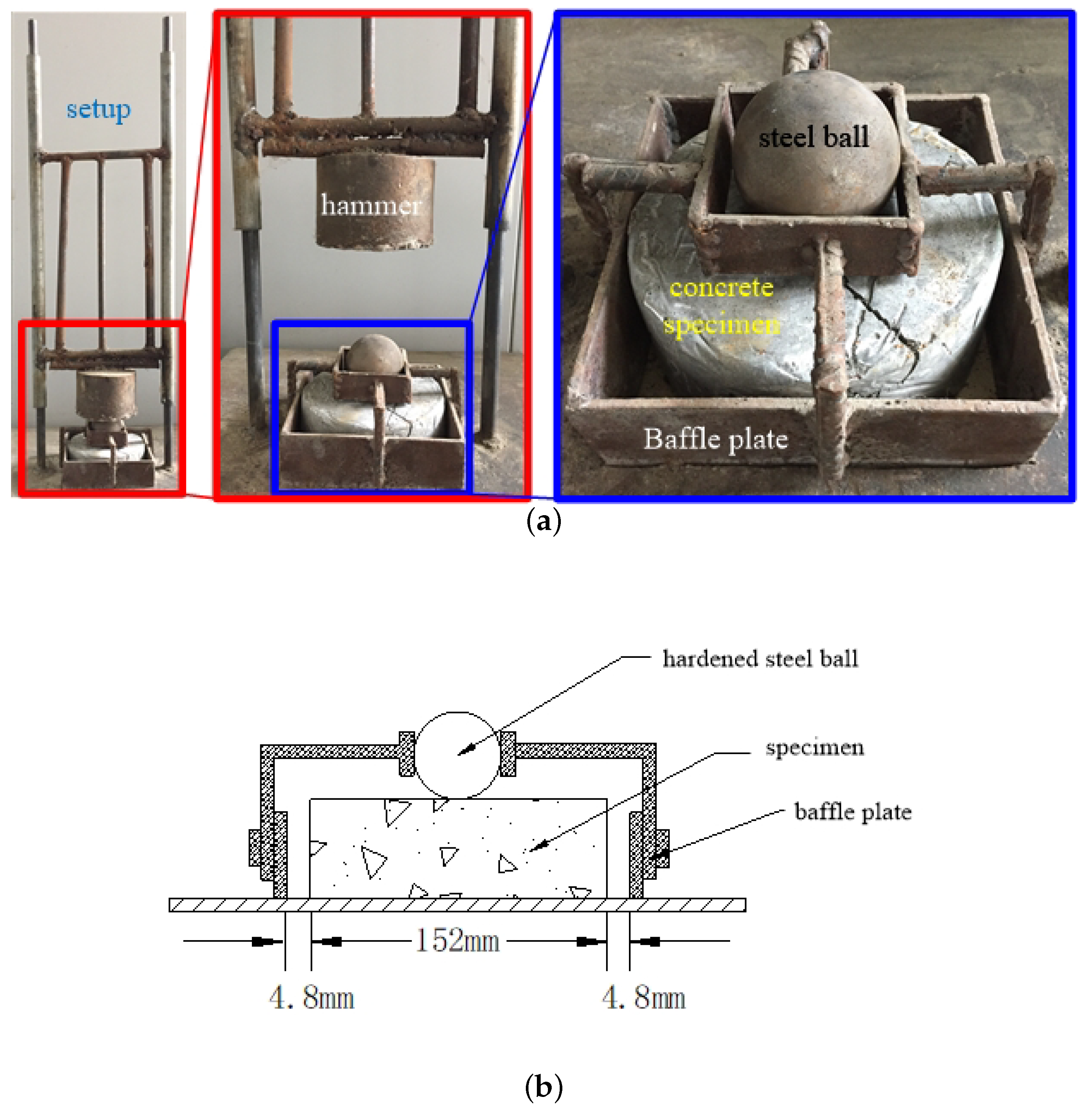

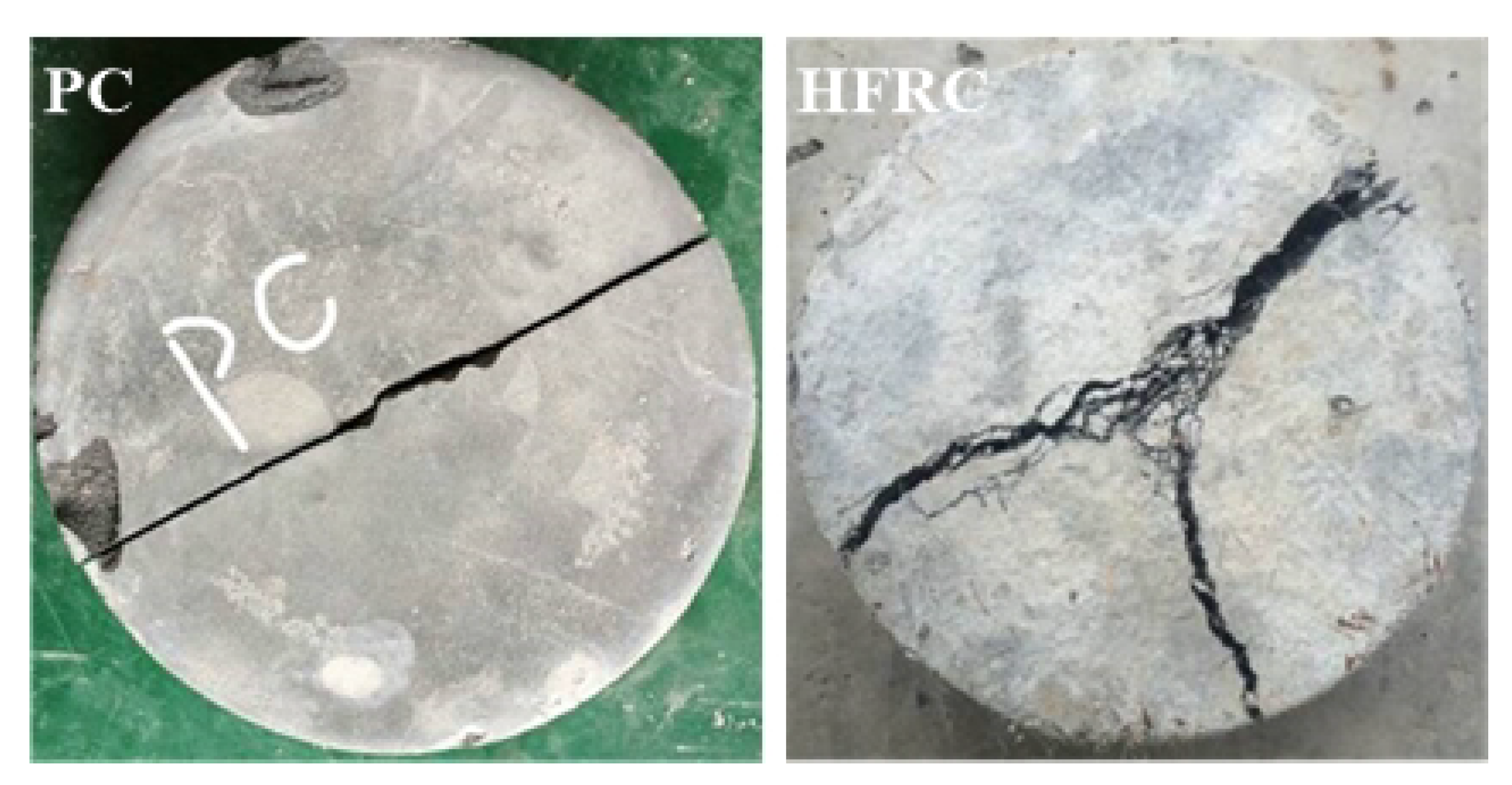
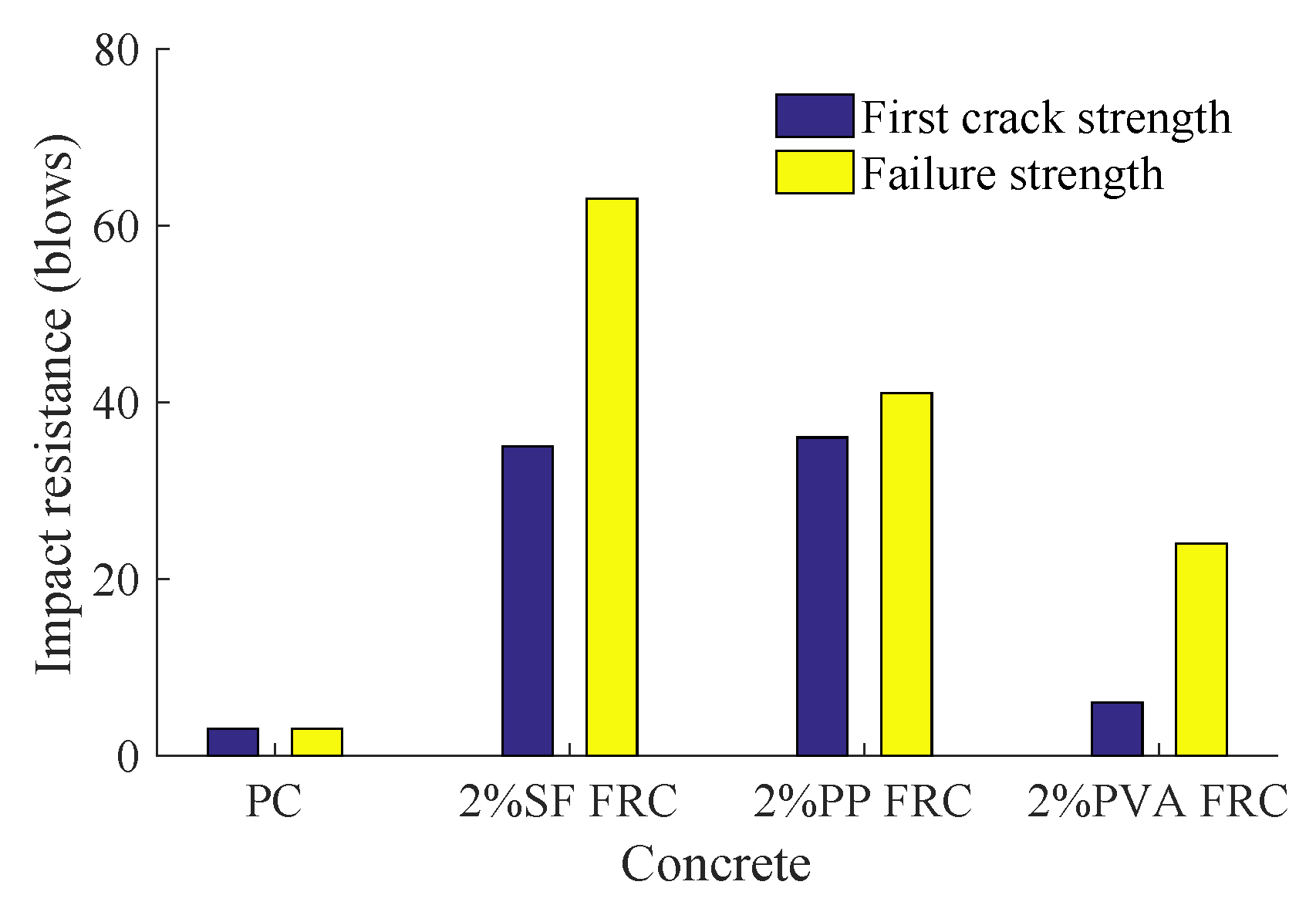
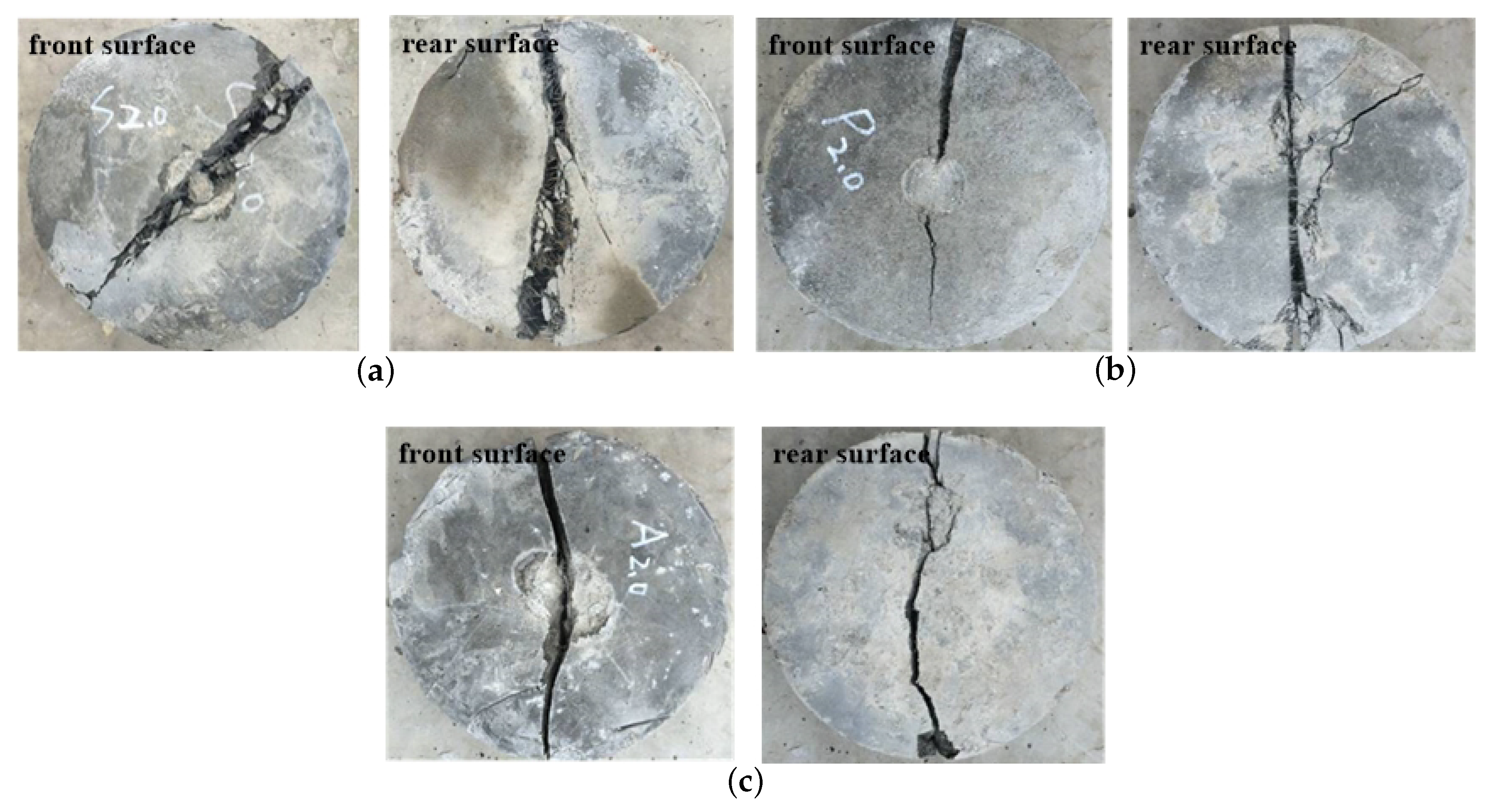
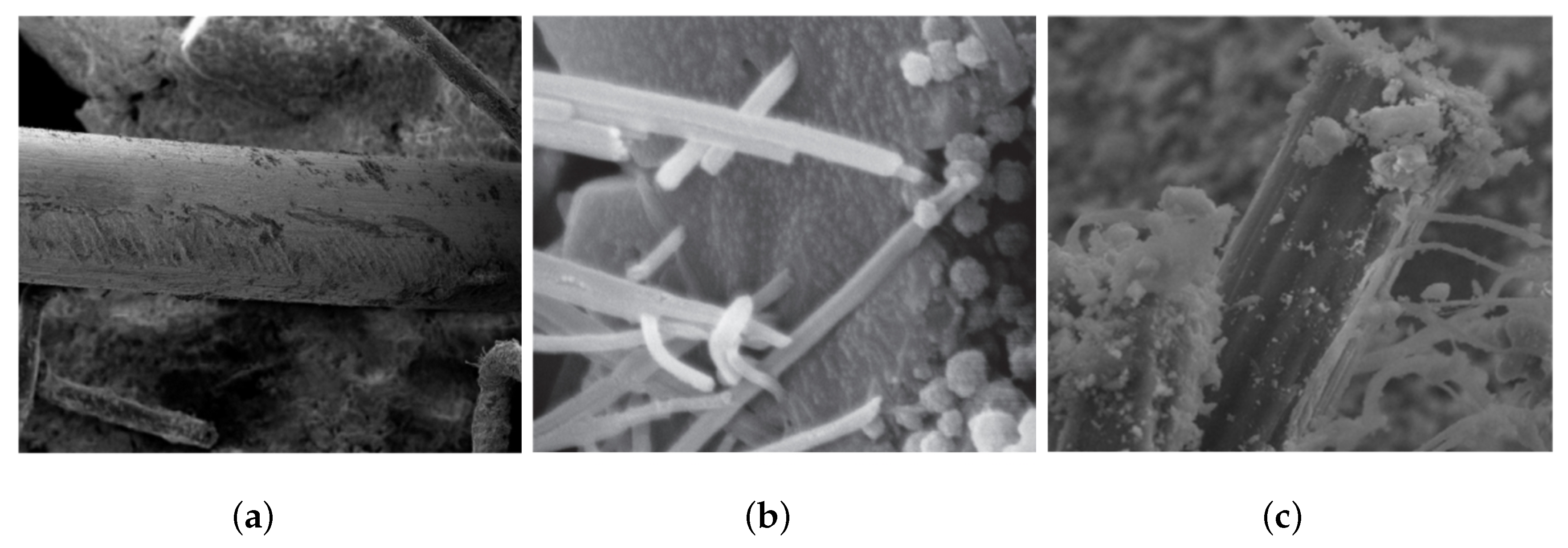

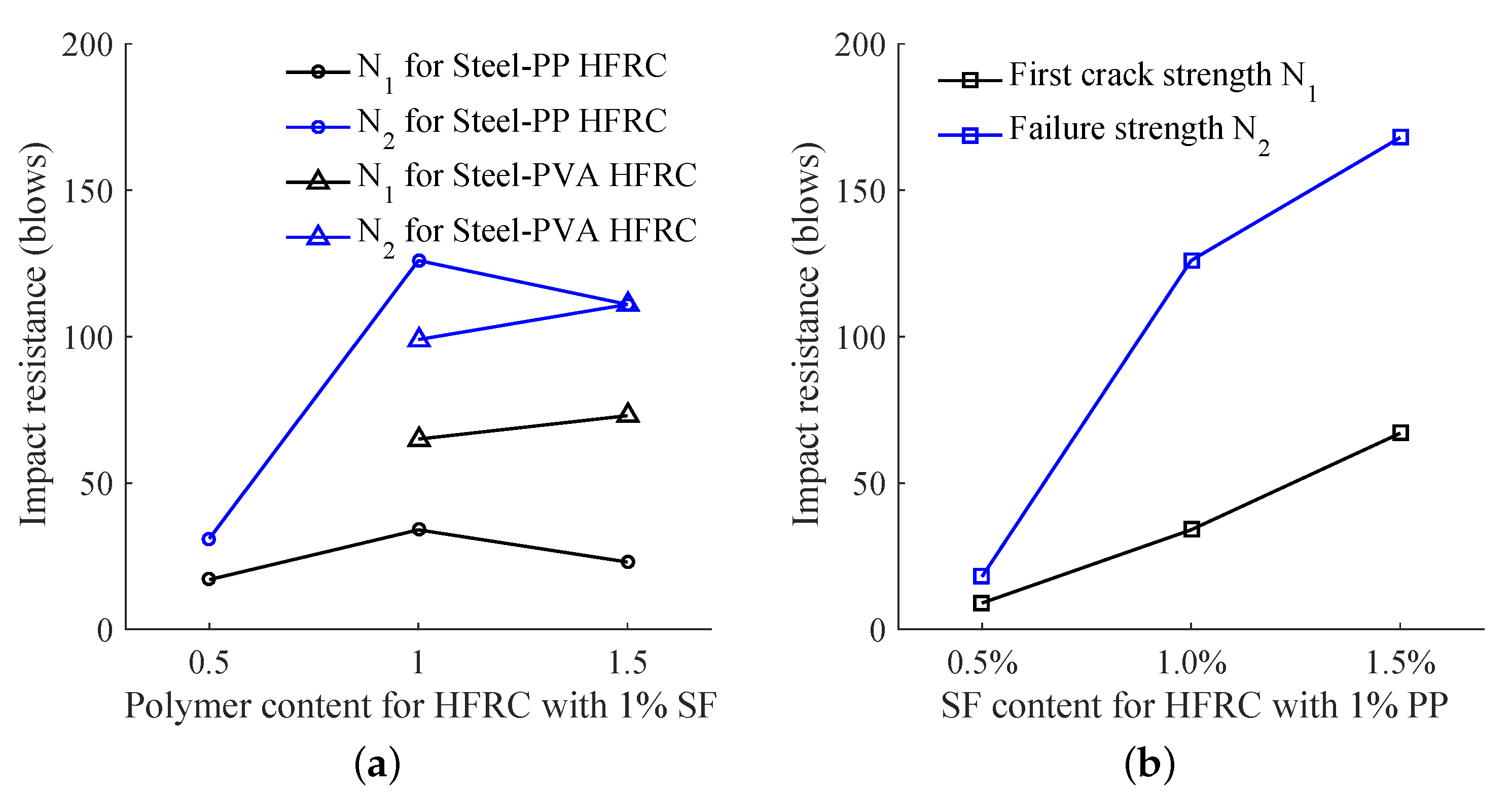


| Item | Cement | Fly Ash | Water | Quartz Sand | Superplasticizer | Fiber |
|---|---|---|---|---|---|---|
| kg/m | 1165.9 | 145.7 | 327.9 | 590.2 | 1.2 | 1.5–2.5% by volume |
| Fiber Type | Diameter (m) | Length (mm) | Density (g/cm) | Tensile Strength (MPa) | Elastic Modulus (GPa) | Elongation % |
|---|---|---|---|---|---|---|
| PP | 30 | 19 | 0.91 | 270 | 3 | 4.0–9.0 |
| PVA | 26 | 12 | 1.30 | 1000 | 8 | ≤40.0 |
| SF | 220 | 12–14 | 7.85 | 1200 | 200 | 3.5–4.0 |
| Mix No. | SF Content | PP Content | PVA Content | 7-d (MPa) | 28-d (MPa) | 7-d (MPa) | 28-d (MPa) |
|---|---|---|---|---|---|---|---|
| PC | 0 | 0 | 0 | 59.79 | 70.57 | 8.67 | 9.82 |
| S | 2.0% | 0 | 0 | 91.67 | 115.66 | 26.95 | 28.99 |
| P | 0 | 2.0% | 0 | 69.38 | 90.10 | 16.18 | 17.64 |
| A | 0 | 0 | 2.0% | 68.55 | 84.81 | 12.34 | 13.5 |
| SP | 0.5% | 1.0% | 0 | 65.84 | 75.26 | 12.21 | 13.79 |
| SP | 0.5% | 1.5% | 0 | 73.84 | 92.98 | 16.96 | 21.21 |
| SP | 1.0% | 0.5% | 0 | 60.67 | 85.17 | 17.03 | 17.53 |
| SP | 1.0% | 1.0% | 0 | 69.13 | 87.24 | 19.36 | 21.57 |
| SP | 1.0% | 1.5% | 0 | 68.77 | 82.32 | 17.81 | 22.85 |
| SP | 1.33% | 0.67% | 0 | 82.35 | 105.92 | 21.22 | 23.52 |
| SP | 1.5% | 0.5% | 0 | 84.57 | 107.76 | 23.99 | 28.77 |
| SP | 1.5% | 1.0% | 0 | 73.93 | 86.26 | 23.58 | 30.84 |
| SA | 0.5% | 0 | 1.5% | 79.27 | 95.76 | 12.85 | 15.53 |
| SA | 1.0% | 0 | 1.0% | 78.87 | 98.35 | 17.56 | 19.37 |
| SA | 1.0% | 0 | 1.5% | 71.85 | 99.62 | 18.74 | 20.45 |
| SA | 1.33% | 0 | 0.67% | 80.42 | 105.42 | 18.55 | 23.66 |
| SA | 1.5% | 0 | 0.5% | 83.65 | 108.55 | 25.25 | 28.62 |
| Mix No. | First Crack Blows (N) | Failure Blows (N) | INPB | ||
|---|---|---|---|---|---|
| PC | 3 | 0.0 | 3 | 0.0 | 0 |
| S | 35 | 6.6 | 63 | 6.6 | 28 |
| P | 36 | 6.6 | 41 | 6.6 | 5 |
| A | 6 | 6.6 | 24 | 6.6 | 18 |
| SP | 9 | 3.2 | 18 | 5.5 | 9 |
| SP | 15 | 5.9 | 42 | 14.8 | 27 |
| SP | 17 | 1.4 | 31 | 3.3 | 14 |
| SP | 34 | 5.1 | 126 | 30.5 | 92 |
| SP | 23 | 4.5 | 95 | 14.5 | 72 |
| SP | 34 | 6.6 | 126 | 41.7 | 92 |
| SP | 35 | 3.5 | 159 | 52.2 | 164 |
| SP | 67 | 7.4 | 168 | 45.0 | 101 |
| SA | 80 | 18.9 | 99 | 36.5 | 24 |
| SA | 65 | 8.1 | 99 | 16.5 | 35 |
| SA | 73 | 15.3 | 111 | 27.5 | 36 |
| SA | 26 | 5.5 | 52 | 12.1 | 26 |
| SA | 25 | 7.9 | 56 | 22.6 | 31 |
© 2018 by the authors. Licensee MDPI, Basel, Switzerland. This article is an open access article distributed under the terms and conditions of the Creative Commons Attribution (CC BY) license (http://creativecommons.org/licenses/by/4.0/).
Share and Cite
Feng, J.; Sun, W.; Zhai, H.; Wang, L.; Dong, H.; Wu, Q. Experimental Study on Hybrid Effect Evaluation of Fiber Reinforced Concrete Subjected to Drop Weight Impacts. Materials 2018, 11, 2563. https://doi.org/10.3390/ma11122563
Feng J, Sun W, Zhai H, Wang L, Dong H, Wu Q. Experimental Study on Hybrid Effect Evaluation of Fiber Reinforced Concrete Subjected to Drop Weight Impacts. Materials. 2018; 11(12):2563. https://doi.org/10.3390/ma11122563
Chicago/Turabian StyleFeng, Jun, Weiwei Sun, Hongzhou Zhai, Lei Wang, Haolin Dong, and Qi Wu. 2018. "Experimental Study on Hybrid Effect Evaluation of Fiber Reinforced Concrete Subjected to Drop Weight Impacts" Materials 11, no. 12: 2563. https://doi.org/10.3390/ma11122563
APA StyleFeng, J., Sun, W., Zhai, H., Wang, L., Dong, H., & Wu, Q. (2018). Experimental Study on Hybrid Effect Evaluation of Fiber Reinforced Concrete Subjected to Drop Weight Impacts. Materials, 11(12), 2563. https://doi.org/10.3390/ma11122563






